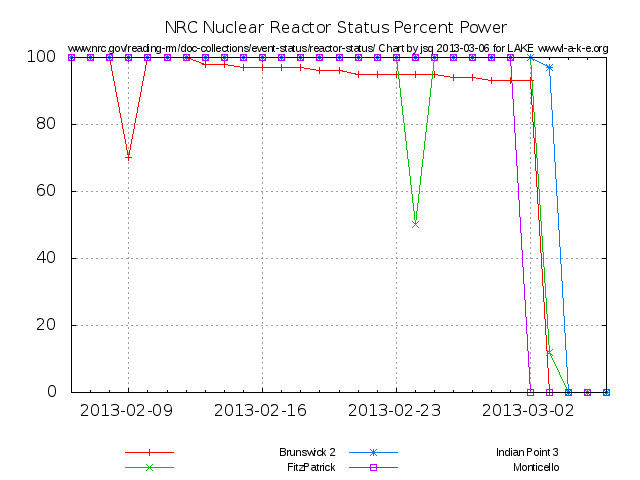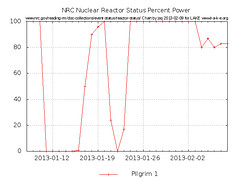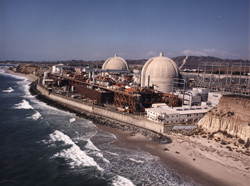| 104 | 100% | total |
| 4 | 3% | newdown |
| 17 | 16% | newlow |
| 6 | 5% | newtop |
| 16 | 15% | down |
| 32 | 30% | low |
| 72 | 69% | top |
Newly down since 23 Feb 2013 on 6 March 2013

Newly down since 23 Feb 2013 on 6 March 2013:
FitzPatrick,
Indian Point 3,
Brunswick 2,
Monticello.
| 104 | 100% | total |
| 4 | 3% | newdown |
| 17 | 16% | newlow |
| 6 | 5% | newtop |
| 16 | 15% | down |
| 32 | 30% | low |
| 72 | 69% | top |

Newly down since 23 Feb 2013 on 6 March 2013:
FitzPatrick,
Indian Point 3,
Brunswick 2,
Monticello.
Twenty seven of 104 NRC status reactors are below 100%, and 15 are at zero power. What happened to supposedly 24/7 nuclear power?
Fifteen are at zero power: Calvert Cliffs 2, Crystal River 3, Diablo Canyon 2, Fort Calhoun, Hatch 1, Hatch 2, La Salle 2, McGuire 1, River Bend 1, San Onofre 2, San Onofre 3, South Texas 2, Turkey Point 3, Turkey Point 4, and Wolf Creek 1. (Seventeen if you count never-started Vogtle 3 and Vogtle 4.)
Sure some of these are down for good (Crystal River 3) and others have been down for a year or more (San Onofre 2 and 3). But
Continue readingWill Georgia Power CEO Paul Bowers say this tritium leak at Plant Hatch is not a problem, like he did about the one in September 2011? Meanwhile, how many tritium leaks have you heard of from solar panels or wind mills?
According to the NRC’s Event Notification Report for February 14, 2013, OFFSITE NOTIFICATION DUE TO TRITIUM RELEASE ONSITE,
“As part of routine rounds on 2/13/13, site personnel discovered an
overflow condition at a collection tank containing water with low levels of tritium (approximately 6,000 pCi/L). The discharge pump for the tank was found to be nonfunctional which resulted in the overflow condition. Following discovery, a portable pump was utilized to pump the water to the normal monitored discharge path and terminate the overflow condition. The exact volume could not be determined but it is estimated that the volume of water that overflowed to the ground was greater than the 100 gallon threshold for voluntary reporting as indicated in Nuclear Energy Institute (NEI) 07-07, ‘Industry Ground Water Initiative-Final Guidance Document.’ A rough estimate of the release is between 100 and 300 gallons. The tritium was contained to a small area on the plant site in the vicinity of the discharge structure, and there is no significant potential for off-site impact or impact to on-site personnel.
“Because the leak remained on site, there will be no offsite impact to drinking water sources. Furthermore, the release posed no threat to employees or the public. Southern Nuclear [SNC] will continue to monitor the affected area as required.
Sure, and they’ve got a ten-mile-radius emergency plan for Plant Hatch, too! Nevermind the Floridan Aquifer that underlies the whole coastal plain hereabouts, and that we drink from over here, only 100 miles from Plant Hatch. The report says they’ll report to the state:
Continue readingMy op-ed in the VDT today; I’ve added links, plus some more after the op-ed.
Continue reading
Finally! Kewaunee, Calvert Cliffs, and now Crystal River permanently closing say it’s time for Georgia to stop wasting money on Southern Company’s already over-budget and increasingly-late nukes and get on with solar power and wind off the coast: for jobs, for energy independence, and for clean air and plenty of clean water.
- February 2013:
- Duke Energy is closing the Crystal River nuclear reactor (Tampa Bay Times, 6 Feb 2013), 160 miles south of us, because nobody wants to pay to fix it: between “$1.5 billion and $3.4 billion, plus what it costs to buy power to replace what Crystal River would have produced while it is being repaired” [Charlotte Business Journal, 11 Jan 2013].
- November 2012:
- NRC terminated Maryland’s Calvert Cliffs 3 (NRC 1 Nov 2012) after Constellation Energy dropped out because the cost “is too high and creates too much risk for Constellation” [Bloomberg 10 Oct 2010].
San Onofre 4 will stay down, if opponents can stop the hidden experiment shell game. Maine Yankee was down for about a year, and never started up again.
Front page of the Bangor Daily News 28 May 1997, Maine Yankee plant may be closed down: Owners weigh repair costs, deregulation,
Maine Yankee President Mike Sellman said that spending will be reduced by about 20 percent, or $41 million, from June through December.
“I think every plant that I’m aware of that has made the decision to essentially curtail start-up activities has then gone ahead shut down permanently,” said Sellman.
Maine Yankee has been off line since Dec. 6, 1966. Several repair and improvement projects had been planned so the plant’s operators could seek Nuclear Regulatory Commission approval to restart and return the plant to service.
See also “It has to close because of the pocketbook.” —Kyle Jones on Maine Yankee nuclear power plant.
-jsq
 Entergy, the company that blacked out the Super Bowl,
now has taken down Massachusetts’ Pilgrim nuclear reactor
in a winter storm.
And that’s not the first time this year.
Plus, what will happen with sea level rise to that nuke on the coast?
Entergy, the company that blacked out the Super Bowl,
now has taken down Massachusetts’ Pilgrim nuclear reactor
in a winter storm.
And that’s not the first time this year.
Plus, what will happen with sea level rise to that nuke on the coast?
Beth Daley wrote for Boston.com this morning, Pilgrim nuclear plant shuts down in storm, Pilgrim Station nuclear plant automatically shut down in the thick of the storm Friday night after losing power, according to a statement by Entergy, the plant’s owner.
Authorities said there is no danger and backup diesel generators are powering safety systems.
“The plant is in a safe, secure condition and will remain on backup power supply until off-site power is restored,” the statement said.
But that’s hardly the whole story. Pilgrim Station has been down about a week lately, and at 80% still other days, according to the Nuclear Regulatory Commission (NRC):
Continue readingGraphs for San Onofre and Diablo Canyon from NRC daily reactor status reports, per request.
 Pride of Southern California Edison Co.,
San Onofre 2 in San Clemente, California,
has been down for more than a year now, since 10 January 2010.
Interesting the way it ramps down down from 100% to below 80% over a week, almost as if
they were trying to cool it off.
Will it
stay down permanently?
Pride of Southern California Edison Co.,
San Onofre 2 in San Clemente, California,
has been down for more than a year now, since 10 January 2010.
Interesting the way it ramps down down from 100% to below 80% over a week, almost as if
they were trying to cool it off.
Will it
stay down permanently?
San Onofre 3 has been down almost a year, since 1 February 2012. Cost of outage for both reactors so far: $317 million as of November.
Continue readingDo you know how many outages nuclear reactors near here have had? Probably not, because that’s usually not in the news, and you have to dig into day by day NRC reactor status reports to find out. It turns out nuclear power is 0/7 instead of 24/7 on many a day.
Looking at all nine nuclear reactors within 200 miles of here, the graph drips downtime like tears.
The available data on NRC’s website and graphed here goes back to 31 March 2006, through 29 January 2013. Let’s look at each of our closest reactors one by one. Hatch 1 on the Altamaha River, in addition to its recent 40% power on 21 January and 87% on 5 January, has had quite a few outages:
Continue readingCalifornia only has a couple of nuclear reactor locations (unlike the 32 reactors within 500 miles of here), and one is in even worse shape than the other: San Onofre, almost as bad as Crystal River. I’m sure Southern Company would never cut corners or have design or construction problems at Plant Vogtle, right?
Harvey Wasserman wrote for AlterNet 7 January 2013, Showdown at San Onofre: Why the Nuclear Industry May Be Dealt a Big Blow,
Perched on an ocean cliff between Los Angeles and San Diego, the
reactors’ owners cut unconscionable corners in replacing their multi-million-dollar steam generators. According to Russell Hoffman, one of California’s leading experts on San Onofre, inferior metals and major design failures turned what was meant to be an upgrade into an utter fiasco.
Installed by Mitsubishi, the generators simply did not work. When they were shut nearly a year ago, tubes were leaking, banging together and overall rendering further operations impossible.
Southern California Edison and San Diego Gas & Electric have unofficially thrown in the towel on Unit 3. But they’re lobbying hard to get at least Unit 2 back up and running. Their technical problems are so serious that they’ve asked the Nuclear Regulatory Commission to let them run Unit 2 at 70% capacity. In essence, they want to “see what happens” without daring to take the reactor to full power.
The NRC has expressed serious doubts. On December 26 it demanded answers to more than 30 questions about the plant’s technical realities. There have been assertions that unless San Onofre can be shown as operable at full power, its license should be negated.
It’s good the NRC got around to doing something, after Continue reading
A writer for Forbes spells out the question of nuclear investment: how can something that expensive, over-budget, late, and phenomenally risky be a good investment, especially when cheaper and faster energy sources are readily available?
Peter Kelly-Detwiler wrote for Forbes today, New Centralized Nuclear Plants: Still an Investment Worth Making?
Just a few years ago, the US nuclear renaissance seemed at hand. It probably shouldn’t have been. Cost overruns from Finland to France to the US were already becoming manifest, government guarantees were in doubt, and shale gas drillers were beginning to punch holes into the ground with abandon.
Then came Fukushima. The latter proved a somewhat astonishing reminder of forgotten lessons about nuclear power risks, unique to that technology: A failure of one power plant in an isolated
location can create a contagion in countries far away, and even where somewhat different variants of that technology are in use. Just as Three Mile Island put the kaibosh on nuclear power in the US for decades, Fukushima appears to have done the same for Japan and Germany, at a minimum. It certainly did not help public opinion, and at a minimum, the effect of Fukushima will likely be to increase permitting and associated regulatory costs.
He goes into detail: they take too long (while gas and solar got cheaper), they’re extremely expensive to build and run, and they’re all-or-nothing investments.
I was going to compile this list of recent nuclear financial failures, but he saves us all the trouble:
Continue reading